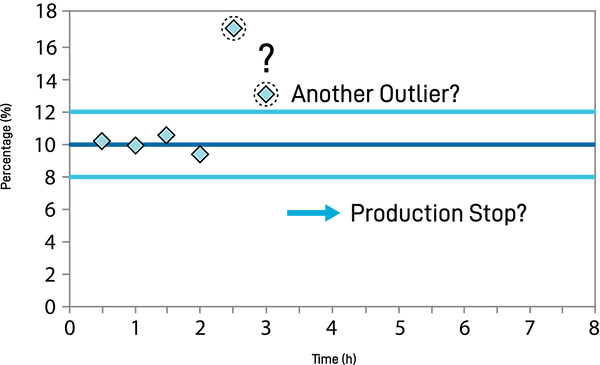**Please note this article is part of a larger series that was first released in the March 2021 Monthly Playbook. If you would like to receive the complete monthly playbook you can sign up here
Cannabis Manufacturing for the 21st Century
Part 4: Chemical Difficulties of Real-time Cannabis Process Control
The general product types used to be bud, oil and tinctures. Today, they are further separated into flower, extract, ingestible, tinctures, edibles, sublinguals, and topicals. Flower is still the most-used format although extracts are expected to have the most growth over the next decade. Currently, cannabis is defined by the two most common active ingredients: tetrahydrocannabinol (THC, psychoactive) and cannabidiol (CBD, non-psychoactive). However, there is a plethora of other cannabinoids, the chemical compounds in cannabis, not to mention terpenes as well as flavinoids.
The decarboxylation of CBDA to CBA[4]

Problems can begin to arise since the science of understanding how the diverse array of cannabinoids interact, individually and in concert, with the body is still in its fledgling stages. As research continues to explode in this area, growers and manufacturers are looking for new ways to improve the efficiency of their processes while being able to control the various cannabinoids in the proper concentrations.
The cannabis plant has over 400 chemical molecules and at least 60 of those are cannabinoids, chemicals unique to the plant. [1] [2] [3]. In the plant, cannabinoids are synthesized (made) and stored as cannabinoid acids. When dried, stored, and heated, the acid group (-COOH) comes off and we get the compounds that we are used to thinking about: CBD and THC. (see Figure 1)
While drying and storing allows partial decarboxylation, heating allows full conversion rates. However, the cannabinoids and the terpenes begin to break down over 300˚F, which can be avoided if a lower heat is applied over time. Thus, most conversion happens over time in temperatures just over 200˚F. A list of several known major cannabinoids is shown below. [5]
CANNABINOIDS
- Tetrahydrocannabinol (THC)
- Delta-8-tetrahydrocannabinol Δ9-THC (or d-8-THC)
- Delta-9-tetrahydrocannabinol Δ9-THC (or d-9-THC) (most common)
- Cannabidiol (CBD)
- Cannabigerol (CBG)
- Cannabichromene (CBC)
- Cannibonol (CBN)
- Cannabinodiol (CBDL)
- Cannabidivarin (CBDV)
- Tetrahydrocannabivarin (THCV)
- Cannabigerivarin (CBGV)
- Cannabichromevarin (CBCV)
There are also over 100 known naturally occurring non-cannabinoid terpenes, the aromatic components, in cannabis. [1] [2] [3]. Research has shown that cannabinoids and terpenes work together, though the mechanism is still not fully understood. Common terpenes in cannabis include myrcene (mango), limonene (lemon), pinene (pine tree), linalool (lavender), caryophyllene (black pepper and cinnamon), humulene (hops, basil,
clove). Myrcene is the primary terpene in cannabis plants and is responsible for its distinctive aroma. [3]. However, pot-smelling canines are trained to detect β-caryophyllene. For many growers, they cultivate certain strains with known concentrations of various terpenes to create unique odors for their products. Many manufacturers buy custom blends made from botanically derived terpenes. [8]
By extracting and separating the various compounds, especially the CBD and THC, the manufacturers can use analytical methods, such as spectroscopy, to quantitatively measure their compounds and control the actual concentrations of the active compounds in their products, and the manufacturers can precisely control the concentrations of their products including oils, edibles, etc. A difficulty arises in spectroscopy as many of the compounds are similar and thus will give similar spectra. As mentioned previously, statistical models are used to help differentiate the compounds to help enable real-time spectroscopic monitoring of the compounds of interest.
References:
- Z. Atakan, “Cannibis, a complex plant: different compounds and different effect on individuals,” Therapeutic
Advanced in Psycopharmacology, vol. 2, no. 6, pp. 241-254, December 2012. - National Cannibis Prevention and Information Centre, “Cannabinoids,” Alcohol Drug & Abuse Center / University
of Washington, 2013. - M. Jacobs, “The Difference Between Cannaboids and Terpenes,” February 2020 2019. [Online]. Available:
https://www.analyticalcannabis.com/articles/the-difference-between-cannabinoids-and-terpenes-311502. - A. Beadle, “CBDA Vs CBD: What are the Differences?,” 18 October 2019. [Online]. Available: https://www.
analyticalcannabis.com/articles/cbda-vs-cbd-what-are-the-differences-312019#:~:text=Once%20CBDA%20
has%20been%20formed,lose%20its%20acidic%20carboxyl%20group. - Way of Leaf, “top 10 Cannabinoids: What Are They and What Do They Do,” Way of Leaf, 28 january 2020.
[Online]. Available: https://wayofleaf.com/education/top-cannabinoids-and-what-they-do. - K. Holland, “CBD vs. THC: What’s the Difference?,” 20 July 2020. [Online]. Available: https://www.healthline.
com/health/cbd-vs-thc#medical-benefits. - M. Dingman, “Neuroscientfically Challenged,” 7 July 2017. [Online]. Available: https://www.neuroscientificallychallenged.com/.
- E. Friedmann, Interviewee, Internal Company Cannabis Discussions. [Interview]. 8 September 2020.











